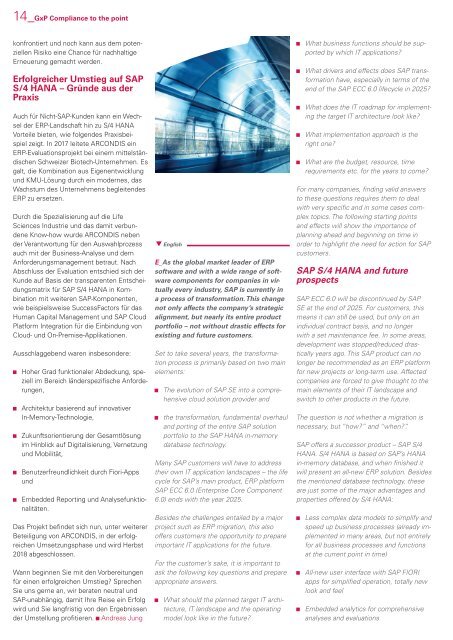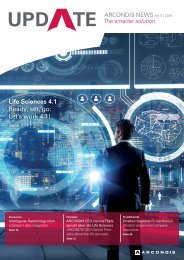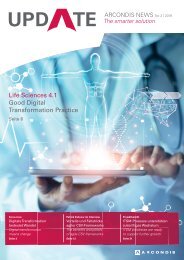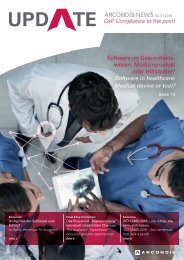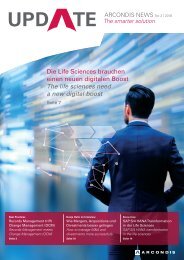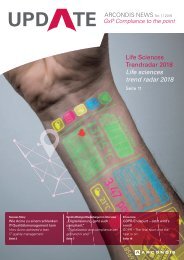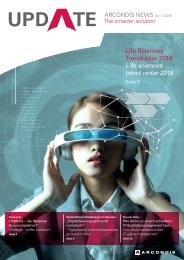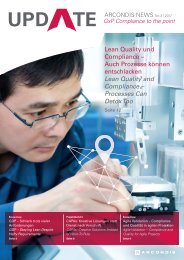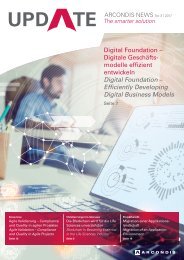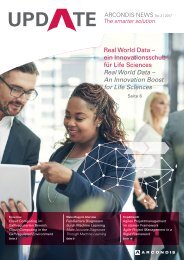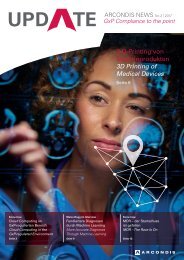ARCONDIS UPDATE No. 02|2018: GxP Compliance to the point
ARCONDIS Kundennewsletter für den Themenbereich Compliance in Medizinprodukteunternehmen
ARCONDIS Kundennewsletter für den Themenbereich Compliance in Medizinprodukteunternehmen
Erfolgreiche ePaper selbst erstellen
Machen Sie aus Ihren PDF Publikationen ein blätterbares Flipbook mit unserer einzigartigen Google optimierten e-Paper Software.
14_<strong>GxP</strong> <strong>Compliance</strong> <strong>to</strong> <strong>the</strong> <strong>point</strong> 15<br />
konfrontiert und noch kann aus dem potenziellen<br />
Risiko eine Chance für nachhaltige<br />
Erneuerung gemacht werden.<br />
Erfolgreicher Umstieg auf SAP<br />
S/4 HANA – Gründe aus der<br />
Praxis<br />
Auch für Nicht-SAP-Kunden kann ein Wechsel<br />
der ERP-Landschaft hin zu S/4 HANA<br />
Vorteile bieten, wie folgendes Praxisbeispiel<br />
zeigt. In 2017 leitete <strong>ARCONDIS</strong> ein<br />
ERP-Evaluationsprojekt bei einem mittelständischen<br />
Schweizer Biotech-Unternehmen. Es<br />
galt, die Kombination aus Eigenentwicklung<br />
und KMU-Lösung durch ein modernes, das<br />
Wachstum des Unternehmens begleitendes<br />
ERP zu ersetzen.<br />
Durch die Spezialisierung auf die Life<br />
Sciences Industrie und das damit verbundene<br />
Know-how wurde <strong>ARCONDIS</strong> neben<br />
der Verantwortung für den Auswahlprozess<br />
auch mit der Business-Analyse und dem<br />
Anforderungsmanagement betraut. Nach<br />
Abschluss der Evaluation entschied sich der<br />
Kunde auf Basis der transparenten Entscheidungsmatrix<br />
für SAP S/4 HANA in Kombination<br />
mit weiteren SAP-Komponenten,<br />
wie beispielsweise SuccessFac<strong>to</strong>rs für das<br />
Human Capital Management und SAP Cloud<br />
Platform Integration für die Einbindung von<br />
Cloud- und On-Premise-Applikationen.<br />
Ausschlaggebend waren insbesondere:<br />
Hoher Grad funktionaler Abdeckung, speziell<br />
im Bereich länderspezifische Anforderungen,<br />
Architektur basierend auf innovativer<br />
In-Memory-Technologie,<br />
Zukunftsorientierung der Gesamtlösung<br />
im Hinblick auf Digitalisierung, Vernetzung<br />
und Mobilität,<br />
Benutzerfreundlichkeit durch Fiori-Apps<br />
und<br />
Embedded Reporting und Analysefunktionalitäten.<br />
Das Projekt befindet sich nun, unter weiterer<br />
Beteiligung von <strong>ARCONDIS</strong>, in der erfolgreichen<br />
Umsetzungsphase und wird Herbst<br />
2018 abgeschlossen.<br />
Wann beginnen Sie mit den Vorbereitungen<br />
für einen erfolgreichen Umstieg? Sprechen<br />
Sie uns gerne an, wir beraten neutral und<br />
SAP-unabhängig, damit Ihre Reise ein Erfolg<br />
wird und Sie langfristig von den Ergebnissen<br />
der Umstellung profitieren. Andreas Jung<br />
English<br />
E_As <strong>the</strong> global market leader of ERP<br />
software and with a wide range of software<br />
components for companies in virtually<br />
every industry, SAP is currently in<br />
a process of transformation. This change<br />
not only affects <strong>the</strong> company’s strategic<br />
alignment, but nearly its entire product<br />
portfolio – not without drastic effects for<br />
existing and future cus<strong>to</strong>mers.<br />
Set <strong>to</strong> take several years, <strong>the</strong> transformation<br />
process is primarily based on two main<br />
elements:<br />
The evolution of SAP SE in<strong>to</strong> a comprehensive<br />
cloud solution provider and<br />
<strong>the</strong> transformation, fundamental overhaul<br />
and porting of <strong>the</strong> entire SAP solution<br />
portfolio <strong>to</strong> <strong>the</strong> SAP HANA in-memory<br />
database technology.<br />
Many SAP cus<strong>to</strong>mers will have <strong>to</strong> address<br />
<strong>the</strong>ir own IT application landscapes – <strong>the</strong> life<br />
cycle for SAP’s main product, ERP platform<br />
SAP ECC 6.0 (Enterprise Core Component<br />
6.0) ends with <strong>the</strong> year 2025.<br />
Besides <strong>the</strong> challenges entailed by a major<br />
project such as ERP migration, this also<br />
offers cus<strong>to</strong>mers <strong>the</strong> opportunity <strong>to</strong> prepare<br />
important IT applications for <strong>the</strong> future.<br />
For <strong>the</strong> cus<strong>to</strong>mer’s sake, it is important <strong>to</strong><br />
ask <strong>the</strong> following key questions and prepare<br />
appropriate answers.<br />
What should <strong>the</strong> planned target IT architecture,<br />
IT landscape and <strong>the</strong> operating<br />
model look like in <strong>the</strong> future?<br />
What business functions should be supported<br />
by which IT applications?<br />
What drivers and effects does SAP transformation<br />
have, especially in terms of <strong>the</strong><br />
end of <strong>the</strong> SAP ECC 6.0 lifecycle in 2025?<br />
What does <strong>the</strong> IT roadmap for implementing<br />
<strong>the</strong> target IT architecture look like?<br />
What implementation approach is <strong>the</strong><br />
right one?<br />
What are <strong>the</strong> budget, resource, time<br />
requirements etc. for <strong>the</strong> years <strong>to</strong> come?<br />
For many companies, finding valid answers<br />
<strong>to</strong> <strong>the</strong>se questions requires <strong>the</strong>m <strong>to</strong> deal<br />
with very specific and in some cases complex<br />
<strong>to</strong>pics. The following starting <strong>point</strong>s<br />
and effects will show <strong>the</strong> importance of<br />
planning ahead and beginning on time in<br />
order <strong>to</strong> highlight <strong>the</strong> need for action for SAP<br />
cus<strong>to</strong>mers.<br />
SAP S/4 HANA and future<br />
prospects<br />
SAP ECC 6.0 will be discontinued by SAP<br />
SE at <strong>the</strong> end of 2025. For cus<strong>to</strong>mers, this<br />
means it can still be used, but only on an<br />
individual contract basis, and no longer<br />
with a set maintenance fee. In some areas,<br />
development was s<strong>to</strong>pped/reduced drastically<br />
years ago. This SAP product can no<br />
longer be recommended as an ERP platform<br />
for new projects or long-term use. Affected<br />
companies are forced <strong>to</strong> give thought <strong>to</strong> <strong>the</strong><br />
main elements of <strong>the</strong>ir IT landscape and<br />
switch <strong>to</strong> o<strong>the</strong>r products in <strong>the</strong> future.<br />
The question is not whe<strong>the</strong>r a migration is<br />
necessary, but “how?” and “when?”.<br />
SAP offers a successor product – SAP S/4<br />
HANA. S/4 HANA is based on SAP’s HANA<br />
in-memory database, and when finished it<br />
will present an all-new ERP solution. Besides<br />
<strong>the</strong> mentioned database technology, <strong>the</strong>se<br />
are just some of <strong>the</strong> major advantages and<br />
properties offered by S/4 HANA:<br />
Less complex data models <strong>to</strong> simplify and<br />
speed up business processes (already implemented<br />
in many areas, but not entirely<br />
for all business processes and functions<br />
at <strong>the</strong> current <strong>point</strong> in time)<br />
All-new user interface with SAP FIORI<br />
apps for simplified operation, <strong>to</strong>tally new<br />
look and feel<br />
Embedded analytics for comprehensive<br />
analyses and evaluations<br />
Various operating models and solutions<br />
(on-premise, private or public cloud solutions)<br />
New technological base architecture for<br />
innovations such as artificial intelligence<br />
(e.g. <strong>to</strong> clear incoming payments)<br />
The new technological HANA basis also enables<br />
integration with SAP solution platform<br />
Leonardo, laying <strong>the</strong> foundation for digitalization<br />
(for example for blockchain, <strong>the</strong> Internet<br />
of Things, etc.).<br />
S/4 HANA is being continuously developed<br />
and, as of <strong>the</strong> second quarter of 2018, it has<br />
reached a good degree of maturity, reflected<br />
in <strong>the</strong> number of cus<strong>to</strong>mer installations<br />
already implemented in many industries and<br />
countries. In individual cases, an analysis is<br />
required, investigating whe<strong>the</strong>r all important<br />
and relevant business processes with<br />
specific requirements, such as integration<br />
with o<strong>the</strong>r IT applications for HR, cus<strong>to</strong>mer<br />
management, and industry-specific requirements<br />
such as integration with lab software,<br />
clinical trials management systems (CTMS)<br />
or manufacturing execution systems (MES)<br />
are covered. This also makes it necessary <strong>to</strong><br />
take a look at <strong>the</strong> entire IT application landscape<br />
with all <strong>the</strong> required IT applications:<br />
What business functions have <strong>to</strong> be supported<br />
for <strong>the</strong> individual cus<strong>to</strong>mer situation with<br />
what IT applications? In <strong>the</strong> target architecture,<br />
S/4 HANA represents <strong>the</strong> core that has<br />
<strong>to</strong> be integrated with o<strong>the</strong>r components in<br />
order <strong>to</strong> achieve optimal process coverage,<br />
especially for <strong>the</strong> specific processes in <strong>the</strong><br />
life sciences industry.<br />
SAP operating models and <strong>GxP</strong><br />
When pondering an architecture, it also<br />
makes sense <strong>to</strong> consider possible operating<br />
models, as <strong>the</strong> trend is clearly heading <strong>to</strong>wards<br />
cloud solutions. More and more often,<br />
public clouds are coming in<strong>to</strong> use, as can be<br />
seen in <strong>the</strong> area of human capital management.<br />
Public clouds offer many advantages,<br />
such as fast rollout times, best practice<br />
approaches and a higher degree of standardization<br />
just <strong>to</strong> name a few. However, <strong>the</strong>y<br />
also have major quirks that should be looked<br />
at with a critical eye for <strong>the</strong> life sciences<br />
industry in particular, including manda<strong>to</strong>ry<br />
release changes each year and <strong>the</strong> associated<br />
testing. For this reason, use of <strong>the</strong> public<br />
cloud <strong>to</strong> support <strong>GxP</strong>-relevant processes in<br />
<strong>the</strong> SAP environment is difficult <strong>to</strong> imagine.<br />
To achieve a validated status, releases would<br />
at least have <strong>to</strong> be documented via regression<br />
testing within <strong>the</strong> few weeks that SAP<br />
gives between <strong>the</strong> release announcement<br />
and upload <strong>to</strong> <strong>the</strong> public cloud. This model is<br />
hardly practical in everyday operations.<br />
From practice, we are familiar with <strong>the</strong> first<br />
<strong>GxP</strong>-relevant SAP S/4 HANA implementation<br />
in <strong>the</strong> private cloud, for example in <strong>the</strong><br />
SAP HANA Enterprise Cloud. High testing<br />
and documentation requirements can be<br />
expected due <strong>to</strong> <strong>the</strong> necessary validation activities.<br />
In addition <strong>to</strong> validation, <strong>the</strong> following<br />
questions are also relevant for using “<strong>GxP</strong> in<br />
<strong>the</strong> cloud”:<br />
How is data availability ensured?<br />
Is <strong>the</strong>re sufficient protection against<br />
manipulation?<br />
Who is responsible for <strong>the</strong> data under<br />
which circumstances?<br />
These <strong>point</strong>s should be addressed during<br />
contract negotiations with <strong>the</strong> provider,<br />
including in <strong>the</strong> private cloud.<br />
The trend <strong>to</strong>wards growing mobility should<br />
also be considered in <strong>the</strong> <strong>GxP</strong> environment,<br />
regardless of <strong>the</strong> operating model selected.<br />
Companies that provide <strong>the</strong>ir users with SAP<br />
apps and dashboards on mobile devices,<br />
for example, should keep in mind that <strong>the</strong>y<br />
have <strong>to</strong> be qualified in <strong>the</strong> same way as <strong>the</strong><br />
infrastructure when processing or s<strong>to</strong>ring<br />
<strong>GxP</strong>-relevant data. A mobile device policy<br />
simplifies this.<br />
Tackling migration<br />
To migrate <strong>to</strong> SAP S/4 HANA, <strong>the</strong>re are<br />
various approaches: The “Brownfield”<br />
approach migrates from SAP ECC 6.0 <strong>to</strong><br />
S/4 HANA maintaining as much cus<strong>to</strong>mizing,<br />
development, data, permissions and<br />
functional coverage as possible. In contrast,<br />
<strong>the</strong> Greenfield approach involves a fully new<br />
implementation. Planning in phases enables<br />
companies <strong>to</strong> manage potential project risks.<br />
An exact plan has <strong>to</strong> be developed specific<br />
<strong>to</strong> <strong>the</strong> cus<strong>to</strong>mer.<br />
Fortsetzung<br />
Continuation


